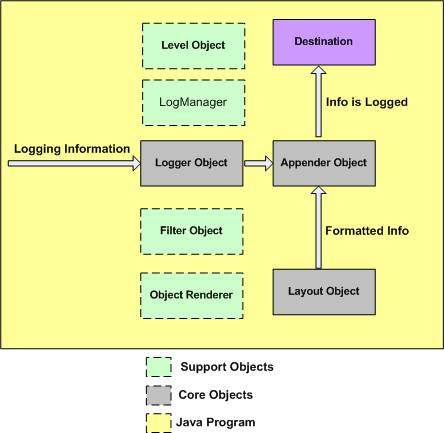log4j API follows a layered architecture where each layer provides
different objects to perform different tasks. This layered architecture
makes the design flexible and easy to extend in future.
There are two types of objects available with log4j framework.
Layout objects play an important role in publishing logging information in a way that is human-readable and reusable.
The following virtual diagram shows the components of a log4J framework:

An Appender objects can have several Filter objects associated with them. If logging information is passed to a particular Appender object, all the Filter objects associated with that Appender need to approve the logging information before it can be published to the attached destination.
There are two types of objects available with log4j framework.
- Core Objects: These are mandatory objects of the framework. They are required to use the framework.
- Support Objects: These are optional objects of the framework. They support core objects to perform additional but important tasks.
Core Objects
Core objects include the following types of objects −Logger Object
The top-level layer is the Logger which provides the Logger object. The Logger object is responsible for capturing logging information and they are stored in a namespace hierarchy.Layout Object
The layout layer provides objects which are used to format logging information in different styles. It provides support to appender objects before publishing logging information.Layout objects play an important role in publishing logging information in a way that is human-readable and reusable.
Appender Object
This is a lower-level layer which provides Appender objects. The Appender object is responsible for publishing logging information to various preferred destinations such as a database, file, console, UNIX Syslog, etc.The following virtual diagram shows the components of a log4J framework:

Support Objects
There are other important objects in the log4j framework that play a vital role in the logging framework:Level Object
The Level object defines the granularity and priority of any logging information. There are seven levels of logging defined within the API: OFF, DEBUG, INFO, ERROR, WARN, FATAL, and ALL.Filter Object
The Filter object is used to analyze logging information and make further decisions on whether that information should be logged or not.An Appender objects can have several Filter objects associated with them. If logging information is passed to a particular Appender object, all the Filter objects associated with that Appender need to approve the logging information before it can be published to the attached destination.

No comments:
Post a Comment